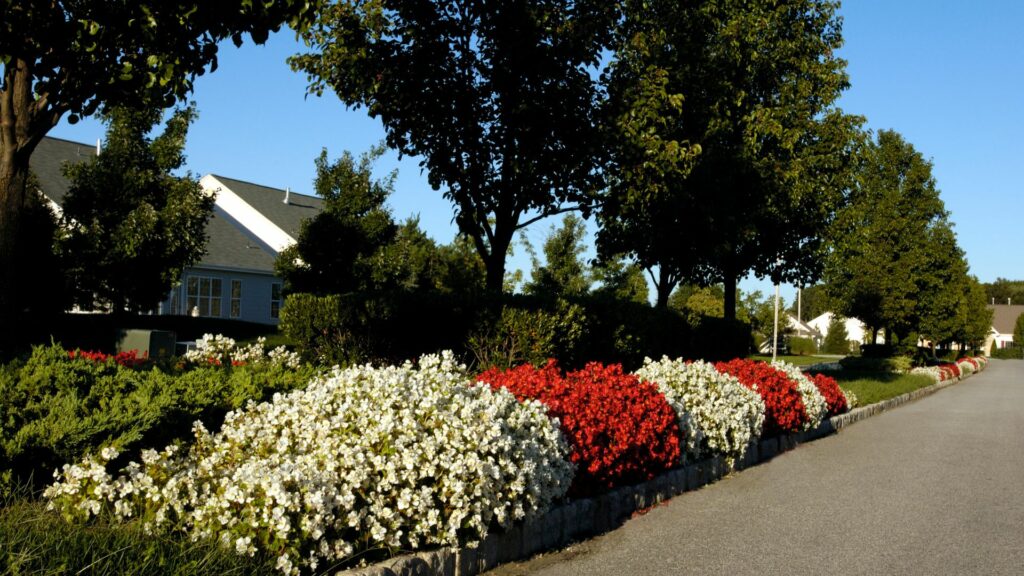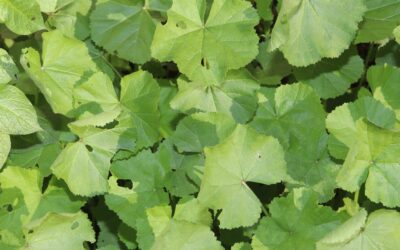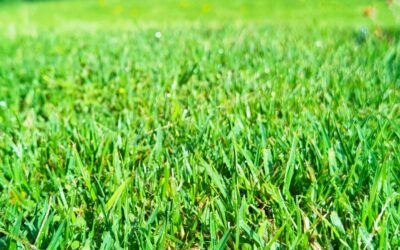Mallow weed is a common problem for commercial facility and property managers, quickly taking over landscapes if not properly controlled. These pesky weeds can be identified by their round, fuzzy leaves and small pink or white flowers. In this ultimate guide, we'll...
Recent Posts
How Lawn Pest Control Enhances Overall Landscape Health
According to recent research by the University of Princeton, lawns account for over 40 million acres of American land today. Maintaining a lush, green space is more than just a matter of aesthetics; it's about creating a healthy, sustainable outdoor environment. One...
The Role of Landscape Maintenance in Enhancing Property Value
You're waiting for potential tenants to arrive at your commercial property for their first viewing. But as you stand in the sunshine, you scan your surroundings and spot a problem. That pathway is cracked. That water fountain isn't working. And when was the last time...
Landscapers often struggle with controlling plant sizes and health. Plant Growth Regulators (PGRs) are organic compounds that modify plant growth. This article will guide you in using PGRs to solve common landscaping challenges.
Read on for a landscaper’s guide to healthier, stronger plants.
Key Takeaways
- Plant Growth Regulators (PGRs) are chemicals that control how plants grow. They can make plants strong and healthy.
- There are different types of PGRs like auxins, cytokinins, and gibberellins. Each one has a special job for plant growth.
- Using PGRs cuts down the need to mow lawns by 40 to 60 percent. This saves time and money.
- Applying PGRs right is important. You must check the weather, measure carefully, and pick the correct time for application.
- Professionals use PGRs in commercial landscaping to make maintenance easier and keep landscapes looking good.
Understanding Plant Growth Regulators

Plant growth regulators are special chemicals that guide how plants grow and develop. They act like the plant’s own hormones, helping with tasks such as leaf formation and root growth.
Definition of plant growth regulators
Plant growth regulators are special chemicals that control how plants grow and develop. They can make plants flower, change the way roots grow, or even slow down aging. These regulators include natural hormones like auxin, gibberellin, cytokinin, ethylene, and abscisic acid as well as man-made substances.
Each group has its own job in managing plant life processes.
These compounds have big roles in landscaping. They help manage how tall or bushy a plant gets and ensure it looks healthy and strong. By using these regulators wisely, landscapers can keep outdoor spaces looking their best without constantly pruning or applying herbicides to control unwanted weeds.
It’s all about giving the right care to get beautiful lawns and gardens.
Types of plant growth regulators (auxins, cytokinins, gibberellins, abscisic acid, ethylene)
Now that we’ve covered what plant growth regulators are, let’s dive into the different types. Each one plays a unique role in managing the growth and health of plants in landscaping.
Auxins
These are like the coaches for plants, directing how they grow and stretch towards light. They help roots dive deep and shoots reach up, making sure flowers show up right where they should.
Cytokinins
Think of cytokinins as the team building experts among plant hormones. They encourage cells to split, helping both leaves and roots grow strong. They’re also stars in tissue culture labs, helping scientists grow new plants from just a few cells.
Gibberellins
These are the growth spurts of the plant world. Gibberellins wake seeds from their sleep and push them to sprout quickly. They make stems stretch taller and leaves expand bigger.
Abscisic Acid (ABA)
ABA is like the wise elder telling everyone to slow down during tough times. When water is scarce or conditions get rough, ABA pumps the brakes on growth to save energy.
Ethylene
This gas might sound simple but has a big job – it tells leaves it’s time to detach when they’re old and helps certain parts of plants mature at just the right time.
Each type of regulator has a special function, from starting seeds germinating to pruning back grown leaves. Using them wisely can help any commercial landscape thrive with strong, healthy plants that look perfect year-round.
Importance of plant growth regulators for landscaping
Plant growth regulators, or PGRs, shape the look and health of landscapes. They help trees and grasses grow well. Using PGRs can make plants strong even when it’s very hot or cold outside.
This means the plants will look good all year round.
PGRs also cut down how often you need to mow lawns by 40 to 60 percent without making the grass quality worse. This saves both time and money for those managing commercial properties.
Plus, these substances ensure that ornamental plants stay at a perfect size, making outdoor areas more beautiful with less work.
Benefits of Using Plant Growth Regulators

Plant growth regulators help keep ornamental plants in shape, making landscapes look neat. They also make roots and stems stronger, leading to healthier plants.
Controlling growth of ornamental plants
Controlling the growth of ornamental plants is crucial for a well-maintained landscape. Plant Growth Regulators (PGRs) like Promalin and Perlan are key tools. They help in modifying plant shapes by increasing branching and keeping shoot growth in check.
This ensures that plants fit their designated spaces and maintain an appealing look.
Weather plays a big role in how well these PGRs work. More specifically, high relative humidity and slow drying conditions make these substances absorb better into the plants. Managers must watch temperature and humidity closely to get the best results from PGR applications on their properties’ ornamentals.
Increasing root and stem strength
Using plant growth regulators (PGRs) can make the roots and stems of your plants stronger. This is crucial for both ornamental and nursery trees in commercial landscapes. Stronger roots hold soil better and absorb more water and nutrients.
This leads to healthier, more resilient plants that can withstand harsh weather, pests, and diseases.
To achieve these benefits, select the right PGRs like indole-3-acetic acid or naphthalene acetic acid. These substances work by encouraging the growth of strong root systems and robust stems.
Apply them properly following label instructions to ensure safety and effectiveness. Strong roots and stems support better overall health in plants, preparing them for a lush appearance all year round.
Next, we will discuss how PGRs also improve the overall health and appearance of plants.
Improving overall health and appearance of plants
After strengthening the roots and stems, plants need proper care to look their best. Plant growth regulators (PGRs) like Apogee or Kudos 27.5 WDG play a big role here. They stop certain parts of the plant from growing too much.
This action helps keep the plant’s shape nice and boosts its health.
Using PGRs also means plants get sprayed better with less risk of getting sick. These substances make sure every leaf has enough space for air and sunlight, reducing places where diseases can hide.
Moreover, by managing how fast a plant grows, PGRs help it stay strong and look appealing for a longer time without unwanted growth spurts.
Selecting and Using Plant Growth Regulators
Choosing the right plant growth regulators involves understanding your landscape’s needs and applying them correctly for healthier plants.
Considerations for choosing the right plant growth regulator
Choosing the right plant growth regulator (PGR) requires understanding your landscape’s unique needs. Look at factors like the type of plants you have, their growth stages, and what you aim to achieve.
If you want to control ornamental plant growth or give strength to roots and stems, knowing these goals helps pick the correct PGR. Different types, such as auxins for rooting compounds and gibberellins for seed germination, serve distinct purposes.
Check your plants’ conditions, including dormant status or maturation stage.
For a well-maintained commercial landscape, proper application methods ensure success with PGRs. Make adjustments based on heavy pruning practices if needed. Understanding timing is crucial too; applying at the wrong time can limit effectiveness or harm plants.
Soil nutrients play a role as well; ensure your soil has the right micronutrients and macronutrients for optimal plant health along with PGR use.
Common plant growth regulators used in landscaping
Knowing how to apply plant growth regulators correctly leads to choosing the right ones for your landscape. Here are some common choices used in commercial landscaping:
- Promalin – This substance mixes two hormones to boost branching in plants. It works well on ornamental trees, encouraging them to branch out and fill in space.
- Perlan – Perlan is great for controlling shoot growth. Using this can make maintenance easier by keeping hedges and bushes compact.
- ProGibb 40SB – This regulator speeds up growth by mimicking a natural hormone in plants. It helps grass recover faster from mowing or foot traffic on lawns and putting greens.
- Ethrel – Ethrel helps with managing how tall plants grow and strengthens stems. It’s very useful in keeping views clear and making sure plants fit their designated spaces without overcrowding.
- Paclobutrazol – A powerful inhibitor that slows down grass growth on lawns, making it perfect for reducing mowing frequency.
Each of these regulators has a specific role in helping your landscape look its best while saving time on upkeep. Proper use ensures strong, healthy plants that enhance commercial properties.
Commercial Landscape Maintenance and Installation Services
Commercial landscaping involves various services to keep properties looking great. These include care for lawns, trees, and other plants. Companies use plant growth regulators (PGRs) to manage how plants grow.
This helps in creating attractive and healthy landscapes that need less trimming and can resist pests better.
For commercial facilities, applying PGRs requires expert knowledge. Professionals make sure they follow specific instructions for each product to get the best results. They also take steps to ensure the treatments work well without harming the environment.
Proper application of PGRs like Promalin leads to stronger trees and more branches without extra pruning needs.
Conclusion
Plant regulators help plants grow well and look great. They make roots and stems strong. Using them the right way is easy and helps a lot. Have you thought about how to use these helpers in your garden? They can change how you care for plants.
Let’s make our gardens the best they can be with these powerful tools!
FAQs
1. What are plant growth regulators?
Plant growth regulators are substances like phytohormones and synthetic auxins that control various aspects of plant growth, including seed dormancy, apical dominance, and fruit development.
2. How do plant growth inhibitors work?
Plant growth inhibitors slow down plant processes such as cell division and elongation, affecting areas like leaf senescence, abscission, and overall primary growth to manage the size and shape of plants.
3. Can you use plant growth hormones to help cuttings develop roots?
Yes, applying plant growth hormones like indole-3 acetic acid can encourage adventitious roots on cuttings, aiding in successful vegetative propagation.
4. Why is understanding apical dominance important for pruning?
Knowing about apical dominance helps landscapers prune correctly to stimulate or restrain the growth of apical buds and shoots for desired shapes and sizes in plants.
5. How does ethylene gas affect plants?
Ethylene gas promotes processes such as fruit ripening and leaf drop (abscission), playing a critical role in the lifecycle management of fruits and other parts of the plant.
6. What role do soil nutrients play in using plant-growth regulators effectively?
Proper nourishment from soil nutrients ensures that plants respond well to applied growth regulators by supporting healthy cell cultures, tissue development, and overall physiological responses necessary for targeted outcomes.
Contact Us
"*" indicates required fields
Recent Posts
Mallow Weed Control: The Ultimate Guide
Mallow weed is a common problem for commercial facility and property managers, quickly taking over landscapes if not properly controlled. These pesky weeds can be identified by their round, fuzzy leaves and small pink or white flowers. In this ultimate guide, we'll...
How Lawn Pest Control Enhances Overall Landscape Health
According to recent research by the University of Princeton, lawns account for over 40 million acres of American land today. Maintaining a lush, green space is more than just a matter of aesthetics; it's about creating a healthy, sustainable outdoor environment. One...



